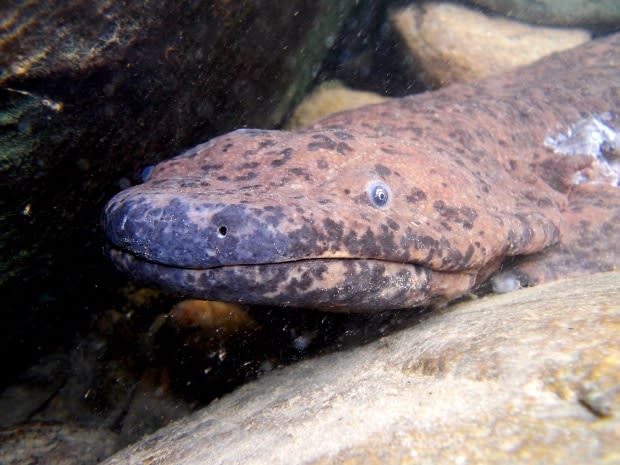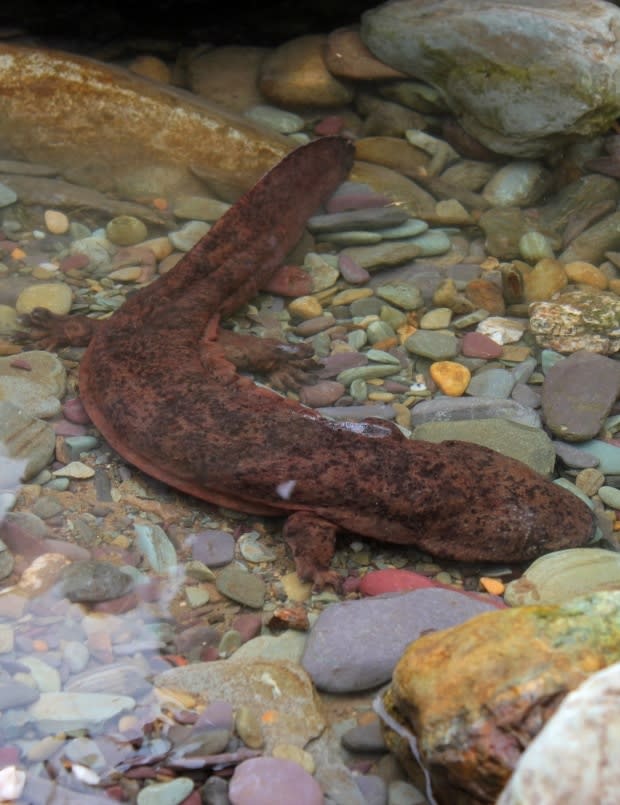New giant salamander species now the world's largest amphibian
Scientists have discovered a new species of giant salamander and concluded that the largest amphibian ever recorded was a member of that species.
For a long time, scientists thought all Chinese giant salamanders, belonged to a single species, Andrias davidianus that was considered the largest amphibian in the world,
But now a genetic study of museum specimens in Canada, the U.K. and the U.S., shows there are actually three different species that live in three different river systems and mountain ranges in China.
And in fact, the largest Chinese giant salamander specimen ever recorded — a 1.8-metre-long individual bigger than most humans — was likely a member of a newly named species from the Pearl River system in Southern China. The species is now known as the South China giant salamander and given the scientific name Andrias sligoi, scientists report this week in the journal Ecology and Evolution.
"For me, the big take-home message is how shocking it is that [we are] just beginning to realize that world's largest amphibians are actually multiple species," said Samuel Turvey, a professor at the Institute of Zoology at the Zoological Society of London and lead author of the new study.
The original name for all Chinese giant salamanders, Andrias davidianus, now applies only the the species from the Yangtze river system.
A third species has also been identified from samples collected by Bob Murphy, senior curator of herpetology at the Royal Ontario Museum in Toronto, in the Yellow Mountains of China in the 1990s. But because those samples represented only parts of animals rather than whole specimens, it could not be officially named as a new species.

Unfortunately, the museum specimens that were analyzed had been dried or preserved in different ways that made it difficult to tell what they looked like originally, which means researchers don't actually know how physically different the different species are.
Giant salamanders aren't colourful like frogs and newts.
"They're these wonderful, weird, big brown blobs, really without that much to differentiate one individual from another," Turvey said.
He added that researchers are now hoping to find some living specimens of each species so they can learn how to tell them apart. Nor do they know if the different species can interbreed, although their last common ancestor was quite a while ago — more than 3 million years — and they were geographically isolated, so they would never encounter each other in the wild.
Sadly, all three species, if they still exist, "are on the very, very edge of extinction," said Turvey.
They're so rare that a huge, "exhaustive" survey that Turvey conducted with Chinese scientists between 2013 to 2016 at almost 100 different sites where giant salamanders were expected to be found turned up only a handful of animals that, based on their genetic profile, likely escaped or were deliberately released from farms.
"Which necessarily doesn't mean that these species are extinct, but it means that they are far, far, far rarer and more threatened than we expected," Turvey said.
Farming: a problem and a solution?
The species are rare in the wild partly because of poaching to stock farms that raise them as a delicacy.
"The farming industry is a huge problem for salamander conservation, but it's there, and it's probably there to stay," Turvey said. Because of that, he said, it needs to be viewed as a resource for conservation.

An earlier genetic study of captive individuals suggested that they might include multiple lineages and even species, but farmed animals have been moved around so much that it was impossible to tell where those lineages might have originated.
That's what prompted the researchers to turn to museum specimens collected in the early 20th century, before the giant salamander farming industry began.
The discovery that there are multiple species is a "game changer" for conservation, Turvey said, as it means giant salamanders can't simply been raised in captivity and released into the wild from the nearest farm, as has been common practice.
The good news, he said, is "it's certainly likely that many if not all of these species still exist within farms, shortly about to be sent to restaurants."
Those could potentially be identified, bred in captivity, and released back into the wild in the right river systems.
The new Pearl River species' scientific name comes from the name originally given to one of the specimens used in the study. It was found in the Hong Kong Botanical Gardens in the 1920s, after being flushed out of a pipe or pool during a storm. It had likely been released as some kind of temple offering, Turvey said.
The animal was studied and named Megalobatrachus sligoi after the Duke of Sligo, who was visiting Hong Kong at the time, but was later reidentified with the scientific name for all Chinese giant salamanders until now, Andrias davidianus.
That animal was sent to the London Zoo, where it lived for 20 years before it died and became a specimen at the Natural History Museum in London.


